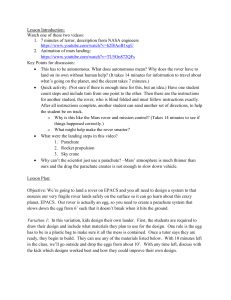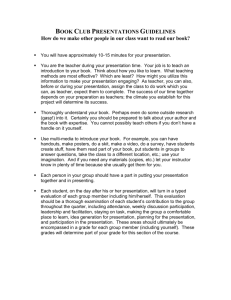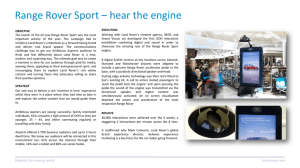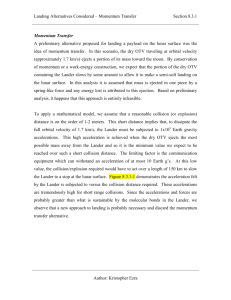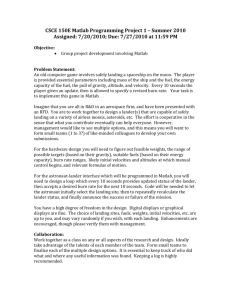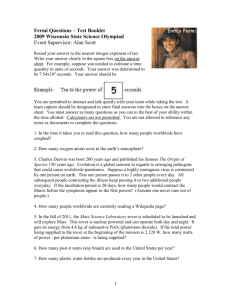Relative position determination between lunar lander and rover
advertisement
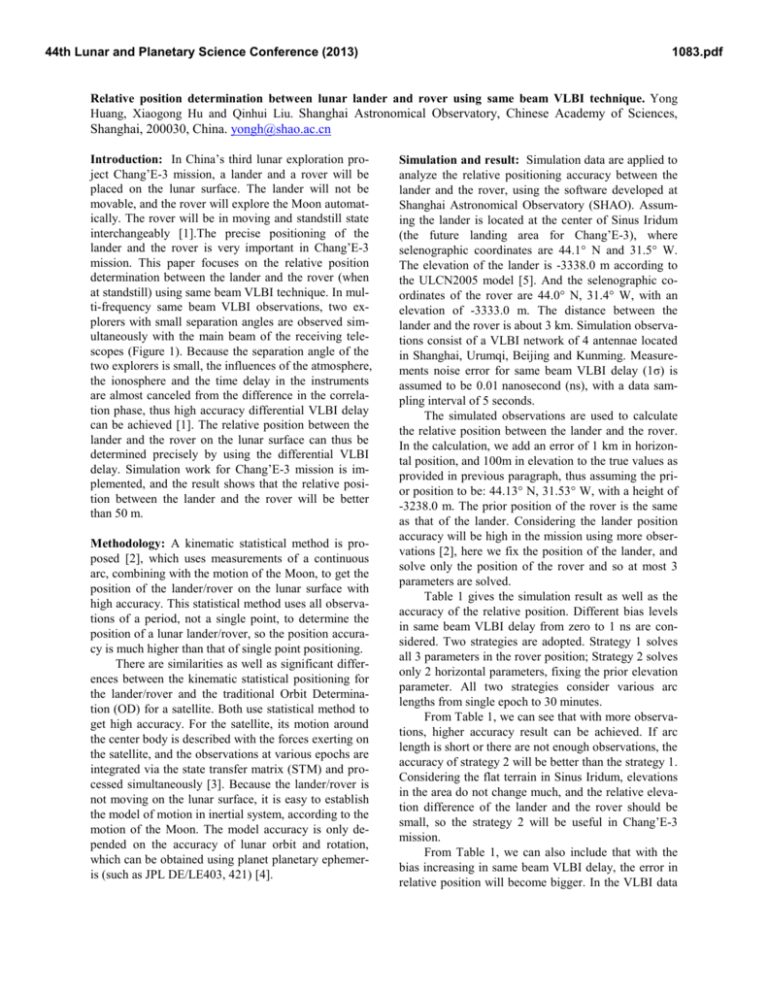
44th Lunar and Planetary Science Conference (2013) 1083.pdf Relative position determination between lunar lander and rover using same beam VLBI technique. Yong Huang, Xiaogong Hu and Qinhui Liu. Shanghai Astronomical Observatory, Chinese Academy of Sciences, Shanghai, 200030, China. yongh@shao.ac.cn Introduction: In China’s third lunar exploration project Chang’E-3 mission, a lander and a rover will be placed on the lunar surface. The lander will not be movable, and the rover will explore the Moon automatically. The rover will be in moving and standstill state interchangeably [1].The precise positioning of the lander and the rover is very important in Chang’E-3 mission. This paper focuses on the relative position determination between the lander and the rover (when at standstill) using same beam VLBI technique. In multi-frequency same beam VLBI observations, two explorers with small separation angles are observed simultaneously with the main beam of the receiving telescopes (Figure 1). Because the separation angle of the two explorers is small, the influences of the atmosphere, the ionosphere and the time delay in the instruments are almost canceled from the difference in the correlation phase, thus high accuracy differential VLBI delay can be achieved [1]. The relative position between the lander and the rover on the lunar surface can thus be determined precisely by using the differential VLBI delay. Simulation work for Chang’E-3 mission is implemented, and the result shows that the relative position between the lander and the rover will be better than 50 m. Methodology: A kinematic statistical method is proposed [2], which uses measurements of a continuous arc, combining with the motion of the Moon, to get the position of the lander/rover on the lunar surface with high accuracy. This statistical method uses all observations of a period, not a single point, to determine the position of a lunar lander/rover, so the position accuracy is much higher than that of single point positioning. There are similarities as well as significant differences between the kinematic statistical positioning for the lander/rover and the traditional Orbit Determination (OD) for a satellite. Both use statistical method to get high accuracy. For the satellite, its motion around the center body is described with the forces exerting on the satellite, and the observations at various epochs are integrated via the state transfer matrix (STM) and processed simultaneously [3]. Because the lander/rover is not moving on the lunar surface, it is easy to establish the model of motion in inertial system, according to the motion of the Moon. The model accuracy is only depended on the accuracy of lunar orbit and rotation, which can be obtained using planet planetary ephemeris (such as JPL DE/LE403, 421) [4]. Simulation and result: Simulation data are applied to analyze the relative positioning accuracy between the lander and the rover, using the software developed at Shanghai Astronomical Observatory (SHAO). Assuming the lander is located at the center of Sinus Iridum (the future landing area for Chang’E-3), where selenographic coordinates are 44.1° N and 31.5° W. The elevation of the lander is -3338.0 m according to the ULCN2005 model [5]. And the selenographic coordinates of the rover are 44.0°N, 31.4°W, with an elevation of -3333.0 m. The distance between the lander and the rover is about 3 km. Simulation observations consist of a VLBI network of 4 antennae located in Shanghai, Urumqi, Beijing and Kunming. Measurements noise error for same beam VLBI delay (1σ) is assumed to be 0.01 nanosecond (ns), with a data sampling interval of 5 seconds. The simulated observations are used to calculate the relative position between the lander and the rover. In the calculation, we add an error of 1 km in horizontal position, and 100m in elevation to the true values as provided in previous paragraph, thus assuming the prior position to be: 44.13°N, 31.53°W, with a height of -3238.0 m. The prior position of the rover is the same as that of the lander. Considering the lander position accuracy will be high in the mission using more observations [2], here we fix the position of the lander, and solve only the position of the rover and so at most 3 parameters are solved. Table 1 gives the simulation result as well as the accuracy of the relative position. Different bias levels in same beam VLBI delay from zero to 1 ns are considered. Two strategies are adopted. Strategy 1 solves all 3 parameters in the rover position; Strategy 2 solves only 2 horizontal parameters, fixing the prior elevation parameter. All two strategies consider various arc lengths from single epoch to 30 minutes. From Table 1, we can see that with more observations, higher accuracy result can be achieved. If arc length is short or there are not enough observations, the accuracy of strategy 2 will be better than the strategy 1. Considering the flat terrain in Sinus Iridum, elevations in the area do not change much, and the relative elevation difference of the lander and the rover should be small, so the strategy 2 will be useful in Chang’E-3 mission. From Table 1, we can also include that with the bias increasing in same beam VLBI delay, the error in relative position will become bigger. In the VLBI data 44th Lunar and Planetary Science Conference (2013) 1083.pdf reduction, the bias will become smaller while arc length increases, so enough arc length is necessary to solve for same beam VLBI bias. In general, from table 1, with arc length of 5 minutes or longer, assuming the bias in same beam VLBI delay will be decreased to about 0.5 ns, the corresponding relative position accuracy between the lander and the rover will be better than 50 m. Table 1. The relative positon accuracy summary (unit: meters) Summary: In this study, the relative position accuracy between the lunar lander and the rover in Chang’E-3 mission is analyzed. A kinematic statistical method is used in the simulation analysis using same beam VLBI observations with a noise level of 0.01 ns. The results show that with arc length of 5 minutes or longer, assuming the bias in same beam VLBI delay will be decreased to about 0.5 ns, the corresponding relative position accuracy between the lander and the rover will be better than 50 m. Bias 0ns Arc 0.2ns 0.5ns 1ns Strategy 1 Strategy 2 Strategy 2 Stragety 2 Stragety 2 Single epoch lat. lon. el. 222.80 226.88 309.04 4.44 0.09 -5 -1.75 -6.99 -5 -10.58 -17.93 -5 -25.61 -35.96 -5 5 min. lat. lon. el. 12.48 9.43 18.53 2.87 0.20 -5 -3.26 -6.87 -5 -12.02 -17.78 -5 -26.90 -35.77 -5 10 min. lat. lon. el. 13.17 16.14 16.87 2.82 0.23 -5 -3.25 -6.83 -5 -11.91 -17.73 -5 -26.65 -35.68 -5 20 min. lat. lon. el. 7.51 10.47 9.03 2.82 0.24 -5 -3.14 -6.79 -5 -11.63 -17.65 -5 -26.07 - 35.54 -5 30 min. lat. lon. el. 0.13 3.13 1.15 2.81 0.23 -5 -3.02 -6.78 -5 -11.34 -17.61 -5 -25.49 -35.45 -5 References: [1] Liu Q. et al. (2010) Sci China, 53(3), 571–578. [2] Huang Y. et al. (2012) Chinese Science Bulletin, 57(35), 4545-4551. [3] Li J. et al. Rover Lander Moon (2011) Sci China (in Chinese), 41(7), 889-895. [4]ftp://sd.jpl.nasa.gov/pub/eph/planets. [5] Archinal B.A. et al (2007). Lunar and Planetary Science, XXXVIII, 1904. τ1 τ3 τ2 τ4 Beijing (50m) Urumqi (25m) Shanghai (65m) Kunming (40m) Figure 1 The same beam VLBI observations between a rover and a lander, and the four Chinese VLBI stations: Beijing (50 m ),Kunming (40 m), Shanghai (65 m) and Urumqi (25 m).
